Prague Castle
| Prague Castle | |
|---|---|
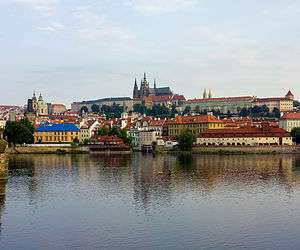 | |
| General information | |
| Architectural style | Baroque and Mannerism |
| Location |
119 08 Prague 1, Czech Republic |
| Current tenants | Miloš Zeman, President of the Czech Republic and the First Lady |
| Construction started | 870 |
| Completed | 1929 |
| Design and construction | |
| Architect | Matthias of Arras and Peter Parler |
| Website | |
| www.hrad.cz | |
Prague Castle (Czech: Pražský hrad; [ˈpraʒskiː ˈɦrat]) is a castle complex in Prague, Czech Republic, dating from the 9th century. It is the official residence of the President of the Czech Republic. The castle was a seat of power for kings of Bohemia, Holy Roman emperors, and presidents of Czechoslovakia. The Bohemian Crown Jewels are kept within a hidden room inside it.
According to the Guinness Book of Records, Prague Castle is the largest ancient castle in the world,[1] occupying an area of almost 70,000 square metres (750,000 square feet), at about 570 metres (1,870 feet) in length and an average of about 130 metres (430 feet) wide. The castle is among the most visited tourist attractions in Prague attracting over 1.8 million visitors annually.[2]
History
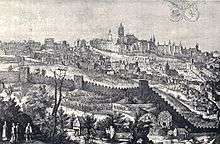
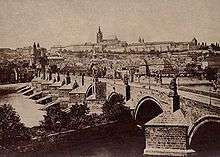
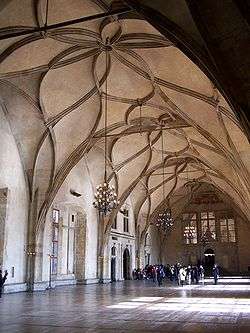
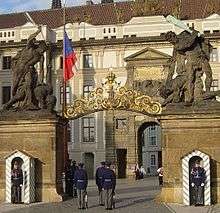
Přemyslid fort
The history of the castle began in 870 when its first walled building, the Church of the Virgin Mary, was built. The Basilica of Saint George and the Basilica of St. Vitus were founded under the reign of Vratislaus I, Duke of Bohemia and his son St. Wenceslas in the first half of the 10th century.
The first convent in Bohemia was founded in the castle, next to the church of St. George. A Romanesque palace was erected here during the 12th century.
Medieval castle
King Ottokar II of Bohemia improved fortifications and rebuilt the royal palace for the purposes of representation and housing. In the 14th century, under the reign of Charles IV the royal palace was rebuilt in Gothic style and the castle fortifications were strengthened. In place of rotunda and basilica of St. Vitus began building of a vast Gothic church, that were completed almost six centuries later.
During the Hussite Wars and the following decades, the castle was not inhabited. In 1485, King Ladislaus II Jagello began to rebuild the castle. The massive Vladislav Hall (built by Benedikt Rejt) was added to the Royal Palace. New defence towers were also built on the north side of the castle.
A large fire in 1541 destroyed large parts of the castle. Under the Habsburgs, some new buildings in Renaissance style were added. Ferdinand I built the Belvedere as a summer palace for his wife Anne. Rudolph II used Prague Castle as his main residence. He founded the northern wing of the palace, with the Spanish Hall, where his precious art collections were exhibited.
The Second Defenestration of Prague in 1618 took place at the castle and began the Bohemian Revolt. During the subsequent wars, the Castle was damaged and dilapidated. Many works from the collection of Rudolph II were looted by Swedes in 1648, in the Battle of Prague (1648) which was the final act of the Thirty Years' War.
The last major rebuilding of the castle was carried out by Empress Maria Theresa in the second half of the 18th century. Following his abdication in 1848, and the succession of his nephew, Franz Joseph, to the throne, the former emperor, Ferdinand I, made Prague Castle his home.
Presidential residence
In 1918, the castle became the seat of the president of the new Czechoslovak Republic, T.G. Masaryk. The New Royal Palace and the gardens were renovated by Slovenian architect Jože Plečnik. In this period the St Vitus Cathedral was finished (on September 28, 1929). Renovations continued in 1936 under Plečnik's successor Pavel Janák.
On March 15, 1939, shortly after the Nazi Germany forced Czech President Emil Hacha (who suffered a heart attack during the negotiations) to hand his nation over to the Germans, Adolf Hitler spent a night in the Prague Castle, "proudly surveying his new possession."[3] During the Nazi occupation of Czechoslovakia in World War II, Prague Castle became the headquarters of Reinhard Heydrich, the Reich Protector of Bohemia and Moravia. He was said to have placed the Bohemian crown on his head; old legends say an usurper who places the crown on his head is doomed to die within a year.[4] Less than a year after assuming power, on May 27, 1942, Heydrich was attacked during Operation Anthropoid, by British-trained Slovak and Czech soldiers while on his way to the Castle, and died of his wounds (which became infected) a week later.[5]
After the liberation of Czechoslovakia and the coup in 1948, the Castle housed the offices of the communist Czechoslovak government. After Czechoslovakia split into the Czech Republic and Slovakia, the castle became the seat of the Head of State of the new Czech Republic. Similar to what Masaryk did with Plečnik, president Václav Havel commissioned Bořek Šípek to be the architect of post-communism Prague Castle's necessary improvements, in particular of the facelift of the castle's gallery of paintings.
Architectural styles of Prague Castle

The castle buildings represent virtually every architectural style of the last millennium. Prague Castle includes Gothic St Vitus Cathedral, Romanesque Basilica of St. George, a monastery and several palaces, gardens and defense towers. Most of the castle areas are open to tourists. The castle houses several museums, including the National Gallery collection of Bohemian baroque and mannerism art, exhibition dedicated to Czech history, Toy Museum and the picture gallery of Prague Castle, based on the collection of Rudolph II. The Summer Shakespeare Festival regularly takes place in the courtyard of Burgrave Palace.
The neighborhood around Prague Castle is called Hradčany.
Churches

- Katedrála svatého Víta, Václava a Vojtěcha (St. Vitus Cathedral)
- Bazilika svatého Jiří (St. George's Basilica, Prague) and Klášter svatého Jiří (St. George's Convent, Prague), it is the oldest surviving church building within Prague Castle.
- Chrám Všech svatých (All Saints Church)
- Kaple svatého Kříže (Holy Cross Chapel)
Palaces
- Starý královský palác (Old Royal Palace)
- Letohrádek královny Anny (Belvedere (Prague))
- Lobkovický palác (Lobkowicz Palace, not to be confused with the German embassy in Malá Strana)
- Nový královský palác (New Royal Palace (Prague))
Halls
- Sloupová síň (Column Hall)
- Španělský sál (Spanish Hall (Prague Castle))
- Rudolfova galerie (Rudolph's Gallery)
- Rothmayerův sál (Rothmayer's Hall)
- Vladislavský sál (Vladislav Hall)
Towers
- Bílá věž (White Tower (Prague Castle))
- Černá věž (Black Tower (Prague Castle))
- Daliborka (Dalibor Tower)
- Prašná věž or Mihulka (Mihulka)
Other buildings
- Zlatá ulička (Golden Lane)
- Staré purkrabství (Old Supreme Burgrave's House )
- Míčovna (Ball Game Hall)
- Jízdárna Pražského hradu (Riding School)
- Staré proboštství (Old Provost Residence )
- Nové proboštství (New Provost Residence)
Gardens

- Královská zahrada (Royal Garden of Prague Castle)
- Oranžérie (Orangery)
- Zahrada na terase Jízdárny (Riding School Terrace Garden)
- Zahrada Na Baště (The Garden on the Bastion)
- Jižní zahrady (South Gardens)
- Rajská zahrada (Paradise Garden)
- Zahrada Na Valech (Garden on the Ramparts)
- Hartigovská zahrada (The Hartig Garden)
- Jelení příkop (Deer Moat)
- Svatováclavská vinice (St. Wenceslas vineyard)
- Produkční zahrady Pražského hradu (Horticultural Gardens)
Structures
- Kohlova kašna (Kohl's Fountain)
- Matyášova brána (Matthias Gate)
- Obelisk (Obelisk)
- Socha svatého Jiří (Statue of Saint George)
In popular culture
Prague Castle is the location in the second level of Indiana Jones and the Emperor's Tomb video game.
It is also mentioned in the video game Assassin's Creed IV Black Flag as a hidden file found in a hacked computer at Abstergo Entertainment.
Notes
- ↑ Guinness Book of Records entry on Pražský hrad
- ↑ NIPOS: Základní statistické údaje o kultuře v České republice - I. díl - kulturní dědictví (muzea, galerie a památkové objekty)
- ↑ Klaus Fischer, Nazi Germany: A New History (New York: Continuum, 1995), p. 433.
- ↑ Mirna Solic, The gate open to the Bohemian crown jewels at Radio Prague.
- ↑ Gerald Reitlinger, The SS: Alibi of a Nation, 1922-1945 (New York: Da Capo Press, 1989), p. 215.
References
| Wikimedia Commons has media related to Prague Castle. |
- Fischer, Klaus. Nazi Germany: A New History. New York: Continuum, 1995.
- Reitlinger, Gerald. The SS: Alibi of a Nation, 1922-1945. New York: Da Capo Press, 1989.
- Virtual visit with map and written commentary (in czech)
- Tourist information - Official tourist website
- Prague Castle - Official website
- History of Prague Castle
Coordinates: 50°05.385′N 14°23.904′E / 50.089750°N 14.398400°E

